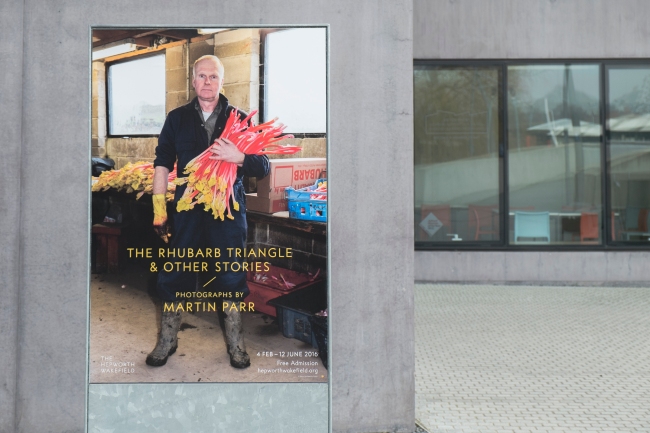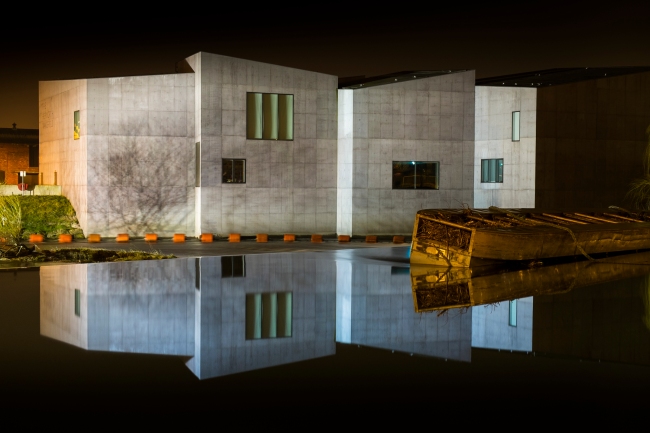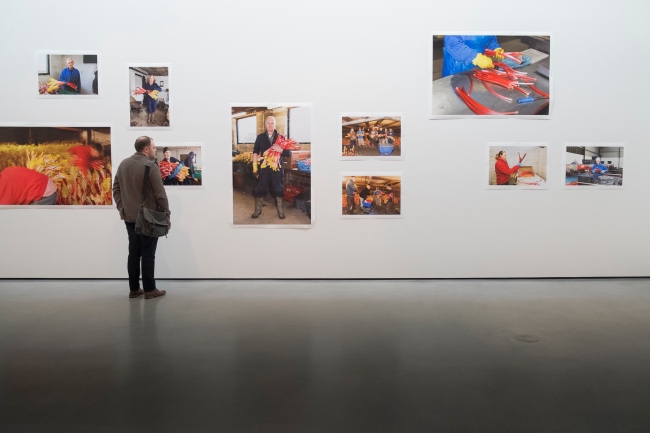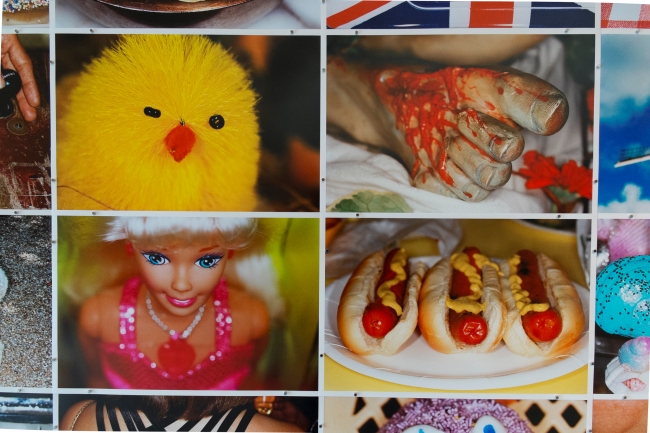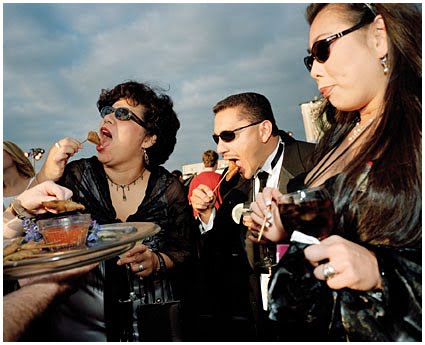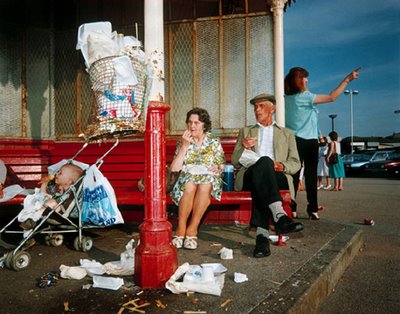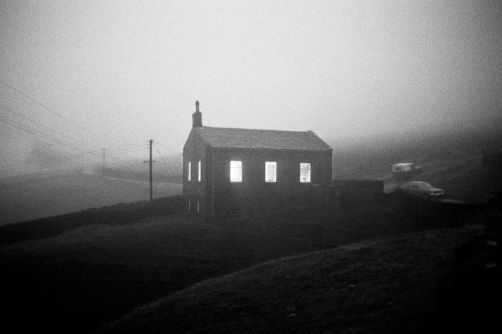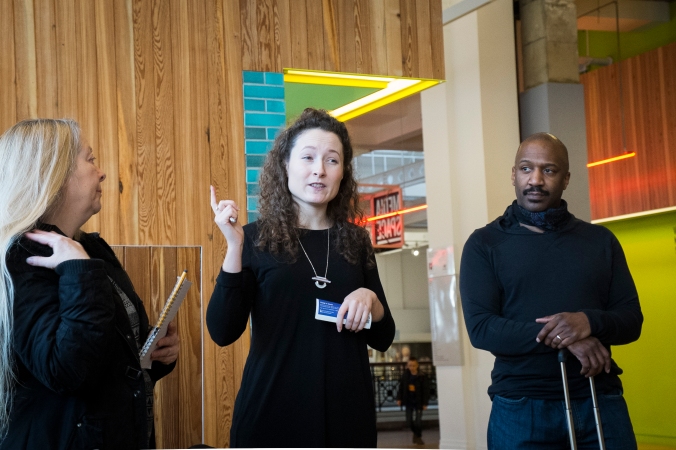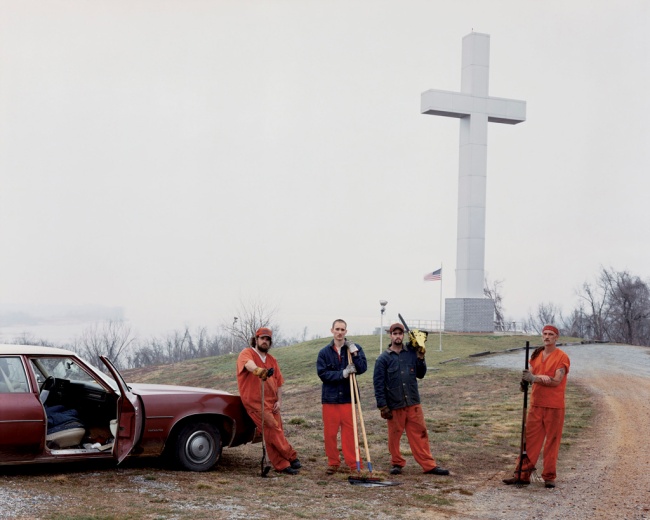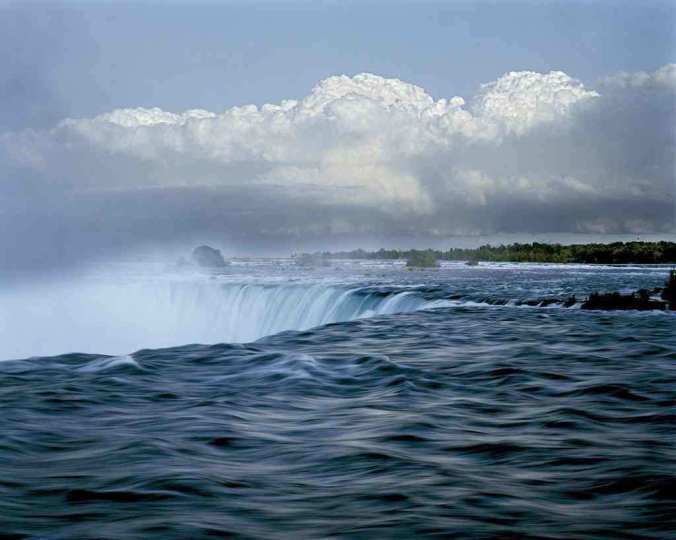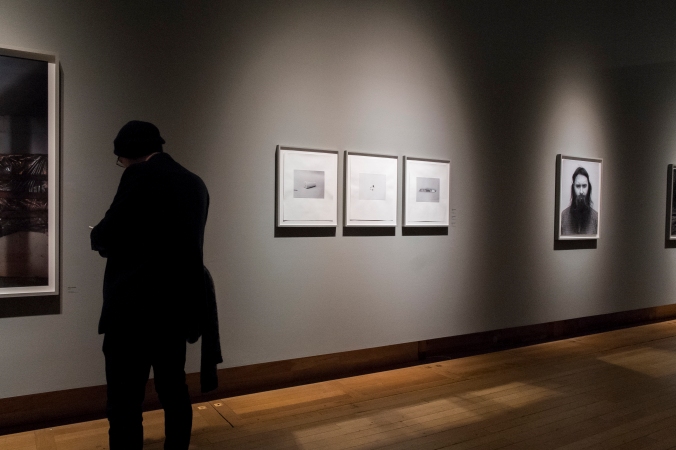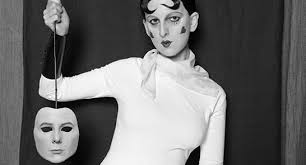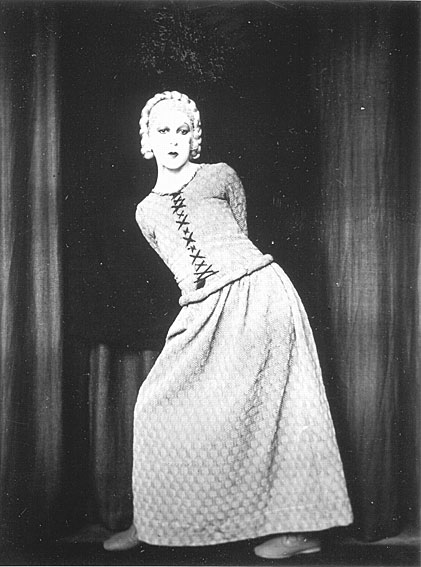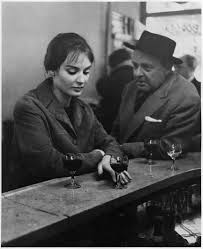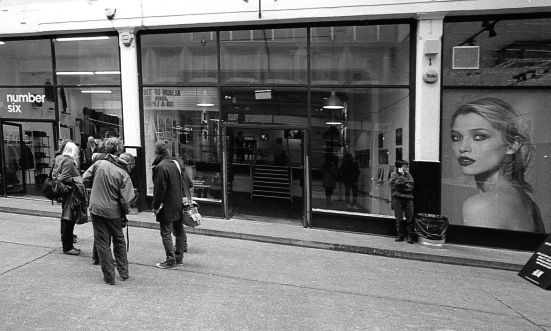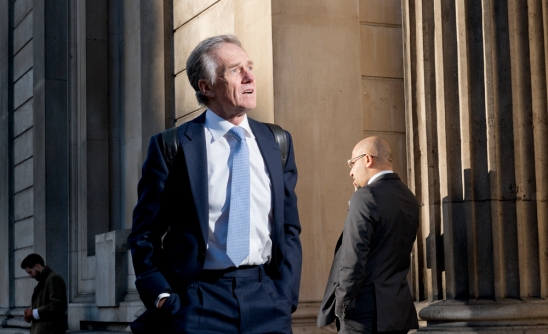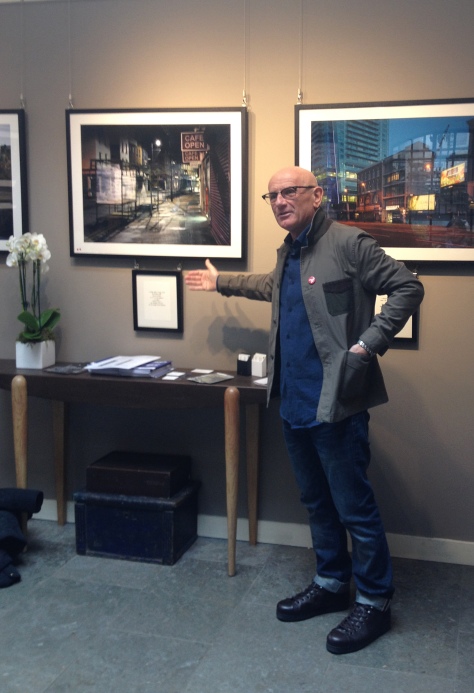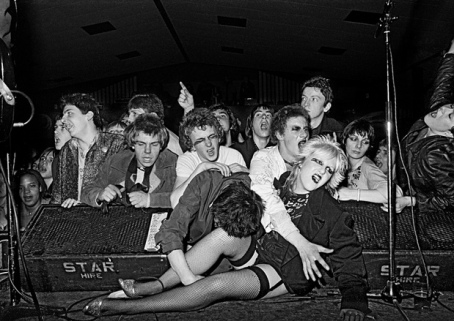Study Visit, 12th March 2016
Context
Rhubarb Triangle and other stories is a collection of work by the British photographer Martin Parr (b1952). I attended the exhibition with the OCA and this was my 5th study visit and the final visit while doing Expressing Your Vision.
The event was led by OCA tutor Derek Trillo and there we 13 other students at the event. As with my other experiences of OCA study visit, the discussion and engagement with other students was really excellent. I have commented on this before in other blog entries, but I really do enjoy these study visits, they have for me offered a much more engaging and enhanced exhibition experience. The opportunity to talk about the work with like minded individuals is both enriching and really has helped develop my thinking and understanding. A big thanks to Derek for leading the group and also Eddie Smith from the OCA office team who joined the group for the visit and contributed to the vibrant discourse on Parr and this work.
The Venue
This was my second visit to the Hepworth and I think it is a wonderful exhibition space with large, light and airy galleries. Named after the Sculptor Barbara Hepworth, who attended a school in the city, the current venue replaces a much more traditional building in the centre of the town (now used as a school). As an unashamed fan of brutalist architecture I love the the interlocking trapezoidal concrete construction of this building which to my mind is utterly inspired. With relatively few visible exterior windows, the light within the gallery during daylight hours is quite frankly remarkable. The exterior of the building’s concrete finish reflects different wavelengths of light in different ways at different times of the day making the external appearance of the structure change in daylight and under artificial light. Having stayed in Wakefield the night before the study visit, I couldn’t resist photographing the Hepworth exterior by night.
The Artist
I have always liked the quirky anti establishment tone of Martin Parr’s work although this was the first time I actually saw his work in the flesh, having until now only seen his images in books and on a screen of one sort or another. Parr seems to divide opinions, as evidenced by the initial reaction to his application to join the Magnum Agency. Some long term members of the agency were reportedly unhappy about the potential of him being accepted into this member led collective. Parr is also one of the early British documentary photographers to move to colour during a time when much documentary work was in black and white. Badger (2009) suggest it was Parr’s exposure to the work of friend and fellow photographer Peter Mitchell that made him look at the potential that colour offered to the documentary photographer. William Egglestone and Stephen Shore are also cited as influences in his shift to colour.
This event at the Hepworth was the first major retrospective of Parr’s work since 2002 held at the Barbican.
The Show- in all its parts
-The Rhubarb Triangle
Central to this exhibition was a new commission, the work that is the title of the show. The Rhubarb Triangle is a collection of images made in the geographical area where forced rhubarb is grown, the triangle being made by the Yorkshire towns of Wakefield, Morley and Rothwell. Forced rhubarb is seen in some circles as being a bit of a delicacy and Parr’s work create’s a pictorial narrative journey in the life of forced rhubarb from its planting in the open, where it is then dug up and moved to the long dark rhubarb sheds where by candle light it is tricked into growing quicker, apparently sweetening it. The work then records its subsequent, picking, packing and consumption in a variety of rhubarb based products. I really liked the linear progress of the work that is in effect telling the story of this unusual crop.
That said, the thing that struck me most when I arrived in the exhibitions space was the sheer scale of the work. Presented as large prints, unmounted, unframed and pinned to the wall with what looked like high tech stainless steel drawing pins, the images fell into three broad categories. These were; posed portraits of individuals and/or groups, images recording people in action, whether in the fields, the rhubarb sheds or on the streets of Wakefield at the annual rhubarb festival. The final category of images were product type images of produce that featured rhubarb in its ingredients. This last type of image made a strong link for me to other Parr work around consumerism where he focused in on the minutiae of food and other products . An example of this at the show was the display of work from Parr’s ‘Common Sense’ series (discussed later).
Apart from the scale and presentation of the images Parr creates for me , a real sense of story in this work that is overt and very transparent. The images themselves which feature the hallmark Parr saturated colours, I felt were really quite beautiful, although I know that not all will agree. The strong pinks and yellows of the rhubarb plants dominated the gallery space although very vivid, I did feel the work was less extreme in the use of colour than other Parr works. The images didn’ t have the ’70s & 80s picture post card colour palette’ of for example: The Last Resort ( discussed later in this review).
I liked all the different categories of image within in the exhibit but some stood out more than others. In particular some of the individual portraits I found to be evocative and inspiring.
The image below is a good example, it is so expressive and could be straight out of a old master painting. Equally some of the images capturing activity have a workshop urgency about them.
Whether you like Parr’s work or not, his technical execution of this work is to my eye without doubt superb. The level of detail, composition and exposure all serve to capture his subjects with a high level of technical competence. The range of material sits well and the narrative of the work is clear and concise to my basic sensibilities!
This is perhaps not a surprise as one of the other OCA students alerted me that Parr made nearly 40,000 images in the execution of this work, these were distilled down to this final set. Whilst this sounds a lot (Frank made 7,500 images that became the 74 photographs that is the Americans, all be it in an area of film) I do wonder though, Parr has perhaps an ulterior motive in the scale of his shooting. As part of my preparation for this study visit I watched the BBC Imagine documentary about Parr. One feature of that stood out in this interesting exposition of Parr the man, was his obsession with collecting. In one scene where he is reviewing contact sheets, he says to Alan Yentob that most of the images on the contact sheet are for his archive and will never be printed. Parr seems to be a collector as well as an image maker.
In all, I was really taken with this work which I feel is sophisticated in its intent and executed beautifully and with the undertaking technical excellence they Parr demonstrates in his work. There is a strong sense of labour and tradition exposed in this work and there is something almost ‘out of time’ about what Parr has recorded here. The thing that really struck home was the sense of cultural record created by this work. There was something almost anthropological or ethnographic about the overall effect of the exhibition on me. It made me think much more widely about Parr’s contribution to a record about our culture. For me the work goes beyond art. Unashamedly I am an absolute fan!
It was also an excellent learning opportunity to compare and contrast The Rhubarb Triangle with several of Parr’s well know other works. I will consider these in turn.
-Work and Leisure
Work and Leisure was an assembled work from a range of Parr projects. It was perhaps the largest gallery space and images of work in various forms, were flanked on the opposite wall with images of people at Leisure. The contrast was somewhat obvious and although I found some of the images intriguing and engaging this part of the exhibition didn’t gell for me the way the other works did. I think it was the sense of anything and everything being photographed that perhaps troubled me the most. There were portrait images of coffee shop ’employee of the month, along side images of technicians working on high tech military aircraft, along side engineering workers in the black country. The image below, which on investigation ( a small BAe logo can be found on close inspection) is I think a scene from the construction of two Trident Submarines has an epic quality and could be a straight publicity image. I got a real sense of Parr the collector in how this exhibit was arranged. I would like to have known more about the curation of this work and how much Parr had a hand in its assembly. My hypothesis is that he did not and this was someone else view of Parr’s work. This is of course just a hunch!
That said there was some excellent images within the set, that did reveal something about Parr’s eye or an image, for something interesting that can contribute to a greater whole. The leisure element of the work had a decidedly beach and sea influence ( a nod to Tony Ray Jones perhaps, as well as parr’s own work at seaside towns. There were other images, many of people at various forms of party or celebration.
Like ‘The Rhubarb Triangle’, this exhibition was predominately printed on a large scale and pinned to the wall. Some of the prints were not particularly flat ( as can be seen in the submarine construction image above) and I think this creates a sense of the temporal and fleeting about the assembly display and ultimate removal of the exhibit. There was no sense of the protection or preciousness of the work, that can be a feature of framed exhibits. I liked the ‘matter of fact’ presentation of these works, the focus was clearly on the content with the presentation being less of an issue.
-Auto Portraits
This is a highly quirky, but I think a revealing exhibit. In it Parr is photographed in a range of portrait styles and approaches reflecting different cultures and widely differing perspectives on what constituents a portrait to be made a preserved . There is something very whimsical about his face in so many genres, some that are quite tacky to my British cultural sensitivities
What at first appears to be just plain funny does I think reveal something about how portrait photography differs from culture to culture, indeed how photography and the still image is seen through the lens of different cultures. I am unsure of Parr’s original intent, but seeing all the individual works displayed simultaneously, rather than leafing through a book, made me think much more about how the portrait is a part of peoples lives in different lands.
On reflection and although I enjoyed seeing it, this work for me did not sit well with the rest of the exhibits and again I pose the question about the curator’s choice in it’s inclusion. I know there are many deciding factors for the curator, one of which might be the artists preference, but also availability can be another critical influencing factor in the the choice of what might form part of a show. I need to learn more about the process of putting on and curating an exhibition.
-Common Sense
On the far wall of the gallery that contained the ‘Work and Leisure’ display, Parr’s well known exhibit , ‘Common Sense’ was displayed. This is classic Parr, showing his keen eye for detail and his mission for finding and recording the absurd. The work says much about consumerism in the UK and the wider world and the lurid colours attest to the man made artificiality of the world around us.
Made up of lots of individual prints of the same size, the work is assembled into a large grid creating a single work from the assembled pieces. I read in the Taylor’s (2004) review of this work that Parr has no preference for how the work is assembled and so again wondered about the selection in this instance and who made the choice about the order and content?
The work really shows Parr’s use of highly saturated colours in part created by the use of a macro lens and ring flash, allowing the artist to work in very close proximity to his subjects. In many case where people are in the images he must have gained a degree of trust to have been allowed to make some other images. The work also includes lots of ‘objects’ of one sort or another, all making reference to consumerism.
I really liked the ‘attack on the senses’ that this work creates and out of the absurdity of some of the content comes so quite profound messages about the world about us. This work also reveals more about Parr as an investigator of culture and society.
-The Cost of Living
I had seen this work in book form and struggled with it. In many respects Parr is recording the mundane through the lens of ‘Thatcherite’ Britain in the middle class communities of Bristol. Parr made the work after moving to Bristol and it creates a window on middle class communities, perhaps as a counter to his critics about his focus on poor communities in work’s like the ‘The Last Resort’.
The images contain many of Parr’s recurring themes, consumerism, community and the consumption of food. In his very person style he is able to make images in very close proximity to his subjects, again attesting to his capacity to gain the trust of those he is photographing.
One thing I really noticed about this set was the less lurid colour palette used. Although Parr still deployed his fill flash and close up lens, and still quite vivid, the work was less extreme than some of he other works.
Of all he works at the show this one engaged me less, perhaps because of my own recollection of Thatcherite Britain in its heyday!
-The Last Resort
This was the work that I was most familiar with although it was great to see it in person. I have owned the book of this work for some time and all the images were familiar to me. Focusing on the resort of New Brighton, parr captures images of families and individual in what i always imagine to be holidays or days out. The colour pallet of the work is reminiscent of seaside post crds of the 70’s and 80′ and create a somewhat unnatural view of the world.
The images create mixed notions for me, they raise questions about the subjects and although they show some poignant family moments, they set these moments in some cases against a back drop of squalor. The scenes of bathers and seaside goers enjoying them selves amongst detritus and litter sits uneasily. Although Parr’s intent was perhaps to show not all was well within Thatchers Britain there is something quite unforgettable about this work. particularly those of children in questionable conditions. The recurrent themes of consumerism, food and leisure all appear in this work, further revealing the threat that run through much of his work.
I know that the work was well received when first shown in Liverpool, but it received a very different reception when shown in London. Parr was accused of exploiting the poor and this critique may well have been an influence in his choice of subject for ‘The most of living’.
All of that said Parr does i believe again she his ability to say some thing greater than the pictorial in this work, he opens a window on the world that might not otherwise have been seen and his images describe something of society, culture and community in 80’s Britain.
-The Non Conformists
This was a genuinely fascinating collection of images to see, not least because it was the earliest work I had seen of the artist. Made while he lived in Hebden Bridge , the work looks at the communities around the Chapels in the hills above the town. They provide a unique insight into communities that were clearly in transition when he made the work. This part of the exhibition also felt very different to the rest of the exhibition. The simple framing behind glass, work printed at a relatively small size and the layout of the images was much more like a documentary photographers exhibitions I had seen by other artists. In saying this I am comparing the show to exhibitions of the work of Cartier Bresson, Kertesz and Brassai, to name just a few. Again I asked my self questions about the nature of the curation and the choices made?
There is a grittiness to the images, very much in the tradition of monochrome documentary photography. That said I think you can see the emerging themes that were to become part of his hallmark. The public consumption of food in particular being a subject he continues to return to.
Some of the images have a real beauty about them to my eye as well as saying something about the community around the chapels he engaged with. The image below has a stark but simultaneaosly inviting feel and seeing it as a framed print at the exhibition, it had been so well printed that it looked to be illuminated from behind!
Key learning from this study visits
- Parr’s work is all the more impressive for being seen as prints, I have been a fan of his work and I know have a greater understanding of why. He appeals to my interest in things beyond the image, thins such as the nature of culture and society. Parr is a sociologists photographer whose work contribute to understanding culture and community.
- Parrs work might be quirky but there is a strong sense of technical prowess. the work is well composed and exposed beautifully, indeed it is full of revealing decisive moments. There is an irony in this, in that I have heard from other students ( although I need to track down a definitive source) that Cartier Breton was vigorously opposed to Parr’s membership of magnum
- Parr does I believe, create a real senses of narrative in his work, he might have a keen eye for the odd and absurd but he is an accomplished story teller in pictures.
- Before seeing this work I very much saw Parr as a bit of an oddity making quirky, but none the less beguiling images. I left the show with a strong sense of the seriousness in this work. Parr routes out and makes visible some otherwise hide truths about the world around us. This is far from trivial and really rather important!
Further lines of study
I am keen to explore some of Parr’s influences further, these include; Tony Ray Jones, Peter Mitchell-in particular his: ‘A New Refutation of the Viking 4 Space Mission’ work and Stephen Shore. I also need to learn more about the curation process and will undertake some private research on this theme.
References
Badger, G. (2009) Quoted from the introductionParr, M (2009) op cit
Parr, M (2009) The Last Resort, Dewi Lewis, London
Taylor, R. (2004) Martin Parr- Common Sense- Tate Summary found at: http://www.tate.org.uk/art/artworks/parr-common-sense-p78371 (Accessed March 2016)
BBC (2003) The World According to Martin Parr, found here ( Accessed March 2016)
